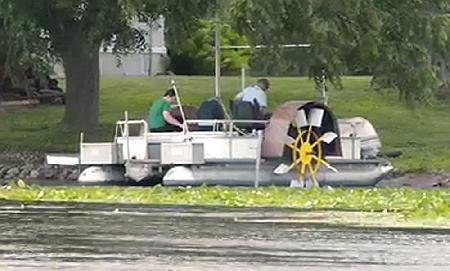Paddle Wheel Pontoon Powered By Zero-Turn Mower

"It's very maneuverable and fun to drive. It also has a lot of pulling power and can go through heavy weeds without slowing down," says Roy Phlipot, Scott, Ohio, who built a one-of-a-kind paddle wheel pontoon boat powered by an old Dixon zero-turn riding mower.
ˇˇˇˇThe boat measures 18 ft. long by 8 ft. wide and floats on a pair of 20-ft. long pontoons. There's no outboard motor on back. Instead, propulsion is provided by a pair of 4-ft. dia. paddle wheels about halfway back on the boat. The paddle wheels are powered by the mower, which is bolted to the deck.
Phlipot started with a 1980's Dixon mower equipped with a hydrostatic transmission, which he bought used from a neighbor. He removed the wheels and deck, then used 3/4-in. cold rolled steel to extend the mower's drive axles out to both sides of the boat. He installed a sprocket with keyway on the outside ends of the axles in order to drive the paddle wheels. He installed another sprocket with keyway on the inside ends of the axles, welding the sprocket to a metal plate that matches the bolt pattern on the rear wheel flanges of the mower.
Each paddle wheel contains eight 12-in. sq. paddles, cut out of 55-gal. plastic barrels and bolted to lengths of angle iron welded to a 15-in. dia. metal plate.
Phlipot uses the mower's steering levers to steer the boat. "Stopping one wheel causes the pontoon to turn in that direction, and by rotating one wheel forward and the other one backward I can turn around on a dime," he says.
He says the pontoon looks a little unconventional, but works great and was inexpensive to build. "I paid $900 for the pontoon and $100 for the mower. I spent most of one winter building it. It took quite a bit of engineering to figure out how many paddles to use and how far to space them apart to be the most effective. When I started working on the idea my fishing buddy thought I was nuts, but now he likes it.
"I came up with the idea because we have a lot of weeds on the lake where I use the boat, and they can easily get caught on propellers. I started out using an ordinary riding mower that drove a paddle wheel mounted on back of the boat. I was able to go through weeds okay but if there was any wind at all steering was a problem, because strong side winds pushed the front end of the pontoon around.
"Side-mounting the paddles solved that problem. Heavy weed beds do cause some drag on the floats, but the paddle wheels will continue to push the boat right on through."
Phlipot says the plastic paddles are designed so the top edge of each paddle stays above the water to avoid picking up weeds. "The paddles just push off the weeds without pulling them up," he says. "They're configured so that as one paddle comes out of the water, the next one goes in which results in constant contact with the water. The steady forward motion makes for a comfortable ride and is also easy on the drivetrain. I drilled a series of holes 2 in. apart vertically into the paddles so they can be adjusted up or down as needed."
